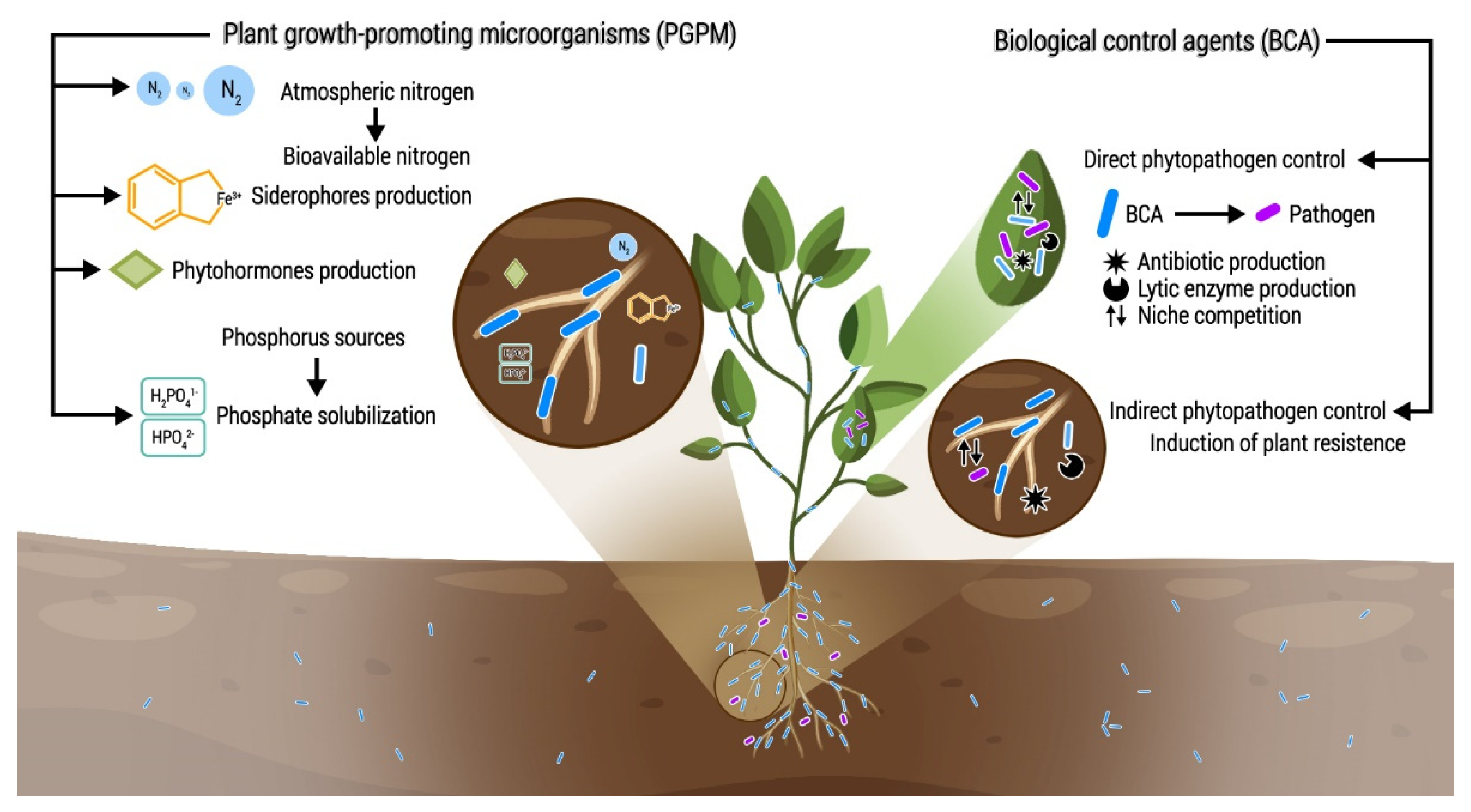Beneficial Microorganisms in Sustainable Agriculture: Harnessing Microbes’ Potential to Help Feed the World
Author Contributions
Funding
Acknowledgments
Conflicts of Interest
References
- FAO. How to feed the World in 2050. In Proceedings of the Expert Meeting on How to Feed the World in 2050, Rome, Italy, 12–13 October 2009. [Google Scholar]
- FAO. The Future of Food and Agriculture—Alternative Pathways to 2050. Summary Version; FAO: Rome, Italy, 2018; p. 60. ISBN 9789251309896. [Google Scholar]
- Hunter, M.C.; Smith, R.G.; Schipanski, M.E.; Atwood, L.W.; Mortensen, D.A. Agriculture in 2050: Recalibrating targets for sustainable intensification. Bioscience 2017, 67, 386–391. [Google Scholar] [CrossRef] [Green Version]
- Tilman, D.; Balzer, C.; Hill, J.; Befort, B.L. Global food demand and the sustainable intensification of agriculture. Proc. Natl. Acad. Sci. USA 2011, 108, 20260–20264. [Google Scholar] [CrossRef] [PubMed] [Green Version]
- Ibarra-Villarreal, A.L.; Parra-Cota, F.I.; Yepez, E.A.; Gutiérrez-Coronado, M.A.; Valdez-Torres, L.C.; de los Santos-Villalobos, S. Impact of a shift from conventional to organic wheat farming on soil cultivable fungal communities in the Yaqui Valley, Mexico. Agrociencia 2020, 54, 643–659. [Google Scholar] [CrossRef]
- Chaparro-Encinas, L.A.; Santoyo, G.; Peña-Cabriales, J.J.; Castro-Espinoza, L.; Parra-Cota, F.I.; de los Santos-Villalobos, S. Transcriptional regulation of metabolic and cellular processes in durum wheat (Triticum turgidum subsp. durum) in the face of temperature increasing. Plants 2021, 10, 2792. [Google Scholar] [CrossRef] [PubMed]
- Santoyo, G.; Guzmán-Guzmán, P.; Parra-Cota, F.I.; de los Santos-Villalobos, S.; Orozco-Mosqueda, M.d.C.; Glick, B.R. Plant Growth Stimulation by Microbial Consortia. Agronomy 2021, 11, 219. [Google Scholar] [CrossRef]
- Fortune Business Insights, Agricultural Microbials Market Size, Share & COVID-19 Impact Analysis, by Type (Bacteria, Fungi, Virus, and Others), Formulation (Dry and Liquid), Function (Soil Amendment and Crop Protection), Application Method (Foliar Spray, Soil Treatment, Seed Treatment, and Others), Crop (Cereals, Oilseeds & Pulses, Fruits & Vegetables, and Others), and Regional Forecast, 2020–2027. Available online: https://www.fortunebusinessinsights.com/industry-reports/agricultural-microbial-market-100412 (accessed on 19 January 2022).
- Lugtenberg, B.; Kamilova, F. Plant-growth-promoting rhizobacteria. Annu. Rev. Microbiol. 2009, 63, 541–556. [Google Scholar] [CrossRef] [PubMed] [Green Version]
- de los Santos-Villalobos, S.; Díaz-Rodríguez, A.M.; Ávila-Mascareño, M.F.; Martínez-Vidales, A.D.; Parra-Cota, F.I. COLMENA: A Culture Collection of Native Microorganisms for Harnessing the Agro-Biotechnological Potential in Soils and Contributing to Food Security. Diversity 2021, 13, 337. [Google Scholar] [CrossRef]
- Parnell, J.; Berka, R.; Young, H.; Sturino, J.; Kang, Y.; Barnhart, D.; Dileo, M. From the lab to the farm: An industrial perspective of plant beneficial microorganisms. Front. Plant Sci. 2016, 7, 1110. [Google Scholar] [CrossRef] [PubMed]
- Siddiqui, Z.A. PGPR: Biocontrol and Biofertilization; Siddiqui, Z.A., Ed.; Springer: Dordrecht, The Netherlands, 2006; ISBN 1402040024. [Google Scholar]
- Köhl, J.; Kolnaar, R.; Ravensberg, W.J. Mode of action of microbial biological control agents against plant diseases: Relevance beyond efficacy. Front. Plant Sci. 2019, 10, 845. [Google Scholar] [CrossRef] [PubMed] [Green Version]

Publisher’s Note: MDPI stays neutral with regard to jurisdictional claims in published maps and institutional affiliations. |
© 2022 by the authors. Licensee MDPI, Basel, Switzerland. This article is an open access article distributed under the terms and conditions of the Creative Commons Attribution (CC BY) license (https://creativecommons.org/licenses/by/4.0/).
Share and Cite
Montoya-Martínez, A.C.; Parra-Cota, F.I.; de los Santos-Villalobos, S. Beneficial Microorganisms in Sustainable Agriculture: Harnessing Microbes’ Potential to Help Feed the World. Plants 2022, 11, 372. https://doi.org/10.3390/plants11030372
Montoya-Martínez AC, Parra-Cota FI, de los Santos-Villalobos S. Beneficial Microorganisms in Sustainable Agriculture: Harnessing Microbes’ Potential to Help Feed the World. Plants. 2022; 11(3):372. https://doi.org/10.3390/plants11030372
Chicago/Turabian StyleMontoya-Martínez, Amelia C., Fannie Isela Parra-Cota, and Sergio de los Santos-Villalobos. 2022. "Beneficial Microorganisms in Sustainable Agriculture: Harnessing Microbes’ Potential to Help Feed the World" Plants 11, no. 3: 372. https://doi.org/10.3390/plants11030372
APA StyleMontoya-Martínez, A. C., Parra-Cota, F. I., & de los Santos-Villalobos, S. (2022). Beneficial Microorganisms in Sustainable Agriculture: Harnessing Microbes’ Potential to Help Feed the World. Plants, 11(3), 372. https://doi.org/10.3390/plants11030372




